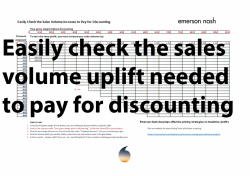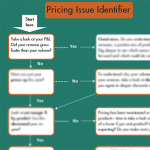Why Bother with a Discount Strategy

To many people, pricing is a bit of an enigma, something we would rather someone else sort out. The problem is not so much with pricing itself but the fact that so few are actually taught about it and it seems far easier to copy what everyone is doing or to work out your costs and just add an amount on top. However, this is not nearly enough.
Pricing, including discounting and promotion, are actually the most important areas of your business as no other elements have a bigger impact on improving profits. The impact of this should not be ignored; a study by McKinsey showed, just 1% increase in price results in an average 11% increase in profits!
If that is not incentive enough, here are 5 other reasons why you need a clear discount structure as part of your pricing policy
1. To stop giving away value for nothing
A buyer would not be doing their job properly if they did not try to negotiate a better price and they will always try. However, you will get the most out of the negotiation if you go in planned for the challenge and have a clear answer ready that is not simply based on ‘how much discount can you afford to give’. If you just give a discount because someone asked, and you got nothing in return, you have given away some of your value for free. It shouldn’t be like this.
There is nothing at all wrong with giving a discount, but it should always be in exchange for something. There are many reasons to give discounts; volume, shorter payment terms, display, exclusivity to name a few. The key is not to give away value for nothing in return. It will always be a negotiation. Find out what is most important to both you and the buyer and work from there. Keep records and include it in your policy. Know what you are prepared to (and can afford to) give away and in exchange for what.
2. To keep track of discounts and avoid a downward spiral
When you are in the process of a retailer deal and the buyer asks for a discount, it is a common instinct to agree. After all, you really want that listing and this seems the only way. You agree to the discount. The next time you are asked for a discount, you remember the first and give the same reduction in price or perhaps even more. And the next time? Before you know it, your price is no longer the one that you first planned, the one that you based your business model on, the one that made sure you made enough money. You receive less and less income and your profits suffer. Use our Discount Checker to keep profits while discounting
Your sales team are keen to prove they are the best, wanting to go out and beat their targets. The sales volumes look great. But have they come at a cost? Have you checked? Do you know? You allow one salesperson to give a larger discount to a big customer, then other members of the sales team copy them. Is that what you wanted? Is it right? You thought you had put through a price increase, but profits are not increasing. Where has the money gone?
If you feel that you are not in control of the prices agreed and that you are not seeing the profits you expect, you would benefit from a thorough review and putting a clear discount structure in place. A clear discount structure demonstrates which discounts are given and when and you can use it to keep track of each customer and the specific reasons they have discounts. It will take time and effort to get it right, but it will be worth it. Otherwise it can be just too easy to take the latest price and discount it a little more to get the deal…
3. To have consistency across your sales team
It is common to reward sales teams with bonuses for hitting their targets. Strong performing sales team are often the lifeblood of the business. After all, without customers, there is no business left. However, how we measure success is key and our policies should reflect what we are trying to achieve so that all are aware and can be treated consistently.
Take a look at the table below for example that shows the targets and results for 3 salespeople tasked with selling items with a list price of £10:
|
Salesperson |
Vol target |
Vol achieved |
Net Price per unit |
Total Revenue |
Cost per unit |
Gross Margin per unit |
Total Gross Margin |
|
A |
1000 |
5000 |
£1 |
£5000 |
£1 |
£0 |
£0 |
|
B |
1000 |
1000 |
£5 |
£5000 |
£1 |
£4 |
£4000 |
|
C |
1000 |
500 |
£10 |
£5000 |
£1 |
£9 |
£4500 |
Who would you rather have working for you?
The one who brings in the most volume, most revenue or most profit? Obviously, there are merits in each of these in different circumstances. However, if the target is only on volume then Salesperson A would be getting all the credit whereas C would be in the ‘doghouse’ even though they did not give as much of a discount and earned the company the most profit. Salesperson C might not have thought there was an option to give a discount and Salesperson A might not have known what the discount limits were (if there were any!). It certainly would not be a ‘fair’ outcome, or certainly not in the eyes of ‘C’.
Now imagine that a discount policy was in place with clear guidelines on possible discount values, reasons, exceptions, sign off limits etc. Customers would be treated similarly, and the sales team would not only be more knowledgeable, but also would all have the same opportunities and ‘tools’ available to them.
4. To reduce impact of customer mergers
Almost daily in the media we hear or read about acquisitions and mergers between companies and the rate has significantly increased over the last 10 years. In fact, there was an increase of 42% between 2010 and 2018! This is not a problem in itself, but it can certainly have a huge impact on pricing and profitability of suppliers if not prepared.
I have seen first-hand the panicked expressions from senior teams when the news breaks that 2 of their biggest customers are merging. The news reports on millions of £ of potential savings the companies are hoping to make. Hoping to make principally from suppliers; either through greater buying power or the merging of terms and prices. Panic sets in and finance and sales rush to try and compare prices on every product sold to those customers to see what the potential loss might be if the cheapest price is given across all the sales. The impact can be huge.
There are far too many examples of where suppliers have been caught out or simply had not realised that they had been giving greater discounts to one customer over another for no clear reason. It doesn’t have to be this way. Companies that have clear pricing tables and discount strategies have been able to clearly defend any pricing differences and have been able to mitigate their losses. I have seen original demands of more than £500k reduced to less than £50k thanks to clear structure and giving discounts for specific criteria in a structured way.
5. To reduce impact of Buyers moving companies
Imagine the scenario, you find out one of your customer’s toughest buyers is leaving their job. The buyer that will not take a price increase, that always battles you to get more discounts and where you end up investing more than anywhere else for feature space. You are pleased they are finally leaving.
That is until you find out that they have moved to another key customer of yours. One that does not have anyway near such favourable pricing. Your heart sinks. How are you going to justify the higher prices to this tough negotiator when they know the prices they got at their previous company? How are you going to keep margins high? Or will you just have to drop prices and suffer the consequences?
Once again, a structured pricing and discount policy can help both in the first instance (additional discounts can only be given for certain gains in return) and also for the second. If your discounts have clear criteria and purpose, it is easier to demonstrate why one company should get them over another.
Summary
The key here is do not leave pricing to chance.
If you know what margins you should be making but you aren’t, if your discounts seem to be increasing but you don’t know why, if your ‘best’ sales teams are not you most profitable ones, if you want to future-proof your pricing and reduce future risks and above all if you want better margins…
… take the time to set out a clear pricing and discount strategy and policy.
The earlier you can implement a clear strategy, the better. Be careful; simply creating your list price to a chosen method is not enough. A true pricing strategy covers all elements that involve the price of a product. Discounting is fundamental in this as it gives us the final price that a customer will pay. It is vital that you have a clear policy for what discounts to give, to whom, and for what reasons. It is equally important that all members of the team both understand the rationale behind the policy and stick to it.
Download: Discount Checker:
Don't loose Money on Discounting Again
Download: Pricing Issues Identifier:
Easily check for issues in your pricing




